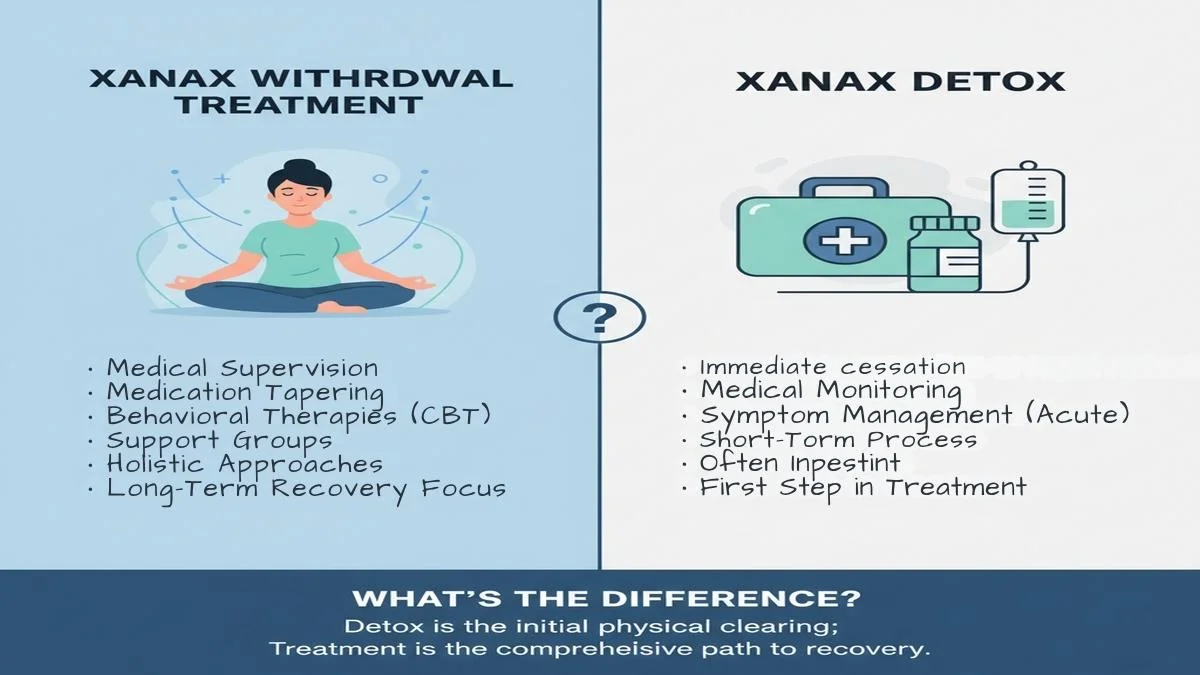HEALTH AND FITNESS
Xanax Withdrawal Treatment and Detox: What’s the Difference?

Beginning the process of overcoming dependence on benzodiazepines often comes down to a simple question: how does detox differ from long-term treatment? For people with anxiety, panic disorders, or sleep problems, there may be a prescription for Xanax. Unfortunately, many people get trapped in a cycle with Xanax that is difficult to break without support or guidance. “Xanax withdrawal treatment” programs are often the most effective and safest first steps. The support of a medically supervised detox is a great primary level of support with ongoing treatment to set the stage for long-term recovery.
Although detox and treatment are often conflated, there are important nuances to understand for effective management of Xanax withdrawal. The most important point is that detox is a legal and medically permitted practice that provides only a physical and temporary solution to dependency on benzodiazepines. Treatment, on the other hand, incorporates a complete plan to structurally and psychologically treat dependency.
Table of Contents
The Role of Detox in Xanax Withdrawal
The initial step in any recovery process is usually detox. Detox is the only step that handles the most pressing issue, which is physical dependence. Xanax? The body gets used to these changes and, when the drug is stopped or reduced, the body scrambles to regain its balance. The body may even fail to regain balance completely.
The physical symptoms of detox are very unpleasant, and in some instances, the symptoms may even be deadly. Complications may include severe anxiety, confusion, and even seizures. The 24/7 support that licensed detox centers provide is necessary in order for a patient to be able to detox comfortably and safely. This process does not solve any problems and only aims to prepare a patient so that they may progress to the next steps in therapy.
Why Xanax Withdrawal Can Be So Intense
Xanax is classified as a benzodiazepine, which means that withdrawal symptoms are very dangerous. This is true even in cases of dependence developing for only a short period of time. This is due to the medication’s short half-life and deeply ingrained potency. The most common withdrawal symptoms include agitation, anxiety, and insomnia. These symptoms will be exacerbated as the body tries to cope without the benzodiazepine.
How severe the symptoms will be depends on how long the person has been on a Xanax regimen, the quantity, and the use of other drugs simultaneously. Most of the time, withdrawal has to be managed both physically and mentally, explaining the need for professional help. Detox centers anticipate this and help clients manage the immediate crisis and begin the process of healing that can be built upon later.
Detox Alone Is Not Enough
Even though sober living is necessary, it does not address the reason why the person started using Xanax in the first place. A person who completes this initial period of management could relapse right back into their preconceived routines when stressors appear. For this reason, the management of withdrawal must be followed with treatment aimed at the person’s mental state, coping mechanisms, and potential for relapse.
Recovery is a long-term process, and while it might just be a week or two, preparation takes much longer. Full recovery will use a combination of techniques, including therapy and education, along with other lifestyle changes, to prepare the person for the sober living that will help them afterward.
The Scope of Withdrawal Treatment
When it comes to Xanax withdrawal treatment, the first step goes beyond just stabilization. Treatment refers to a complete continuum of care, which may entail residential care, outpatient therapy, and aftercare counseling. This approach highlights the reality that dependency is not confined to the physical realm. Dependency straddles the mind, the emotions, and the relational world.
To a great extent, therapists and counselors guide clients to understanding the reasons behind their dependency on Xanax, for some, anxiety disorders, and trauma, and ease misuse. For some, stressful and challenging life situations may create reliance that escalates dependency. The withdrawal treatment programs aimed at dependency provide positive substitute coping mechanisms and life rebuilding strategies.
Emotional Healing
The emotional fallout after withdrawal is one of the most underestimated challenges during recovery. The calming effect of Xanax is removed, and anxiety surges are highly expected. While medication-assisted detox can ease the process, anxiety can escalate due to the uncertainty and fear that the overcoming is very real. Clients gain the ability to cope with triggers sans medication through evidence-based strategies like cognitive behavioral therapy (CBT). Other treatments that focus on restoring one’s emotional equilibrium involve mindfulness training, holistic therapies, and stress management. This combination of medicine and therapy enables individuals to advance positively.
The Importance of a Safe Environment
One major distinction between detox and treatment is the environment in which they occur. Detox is done in a medical setting that is controlled and with constant supervision. However, treatment may move to different places, like outpatient clinics and residential centers. For each of these environments, they have specific designs to contain and lessen risk during vulnerable periods of recovery.
Having warm and empathetic staff around is a great source of emotional support. The isolation that withdrawal brings is accompanied by fear, doubt, and guilt. However, with a support network around them, individuals are encouraged to move forward with the withdrawal process, dissuading them from the temptation to relapse.
Filling The Void After Xanax
When it comes to withdrawal treatment, the goal is to build a life that does not incorporate medication or any other form of medication. After the body gets used to life with no Xanax, you can begin to build routines and systems that are aimed at your long-term goals.
Building your life through family therapy, peer support groups, and life skills development enables you to cope with stress and rebuild relationships and pursue other goals without the fear of relapse. This stage is highly important and is meant to build the life of your dreams.
Integration of Detox and Treatment
Detox and treatment are not meant to be separated; they are different stages of one journey. Detoxing is the first phase of the healing process, therapy is the second, and you will not be able to bounce back without both.
The integration of both systems provides a solid foundation to build your new life. The transition from medical stabilization to therapeutic growth ensures that recovery addresses both body and mind. This is how you can be sure to remain Xanax free for life. The chances of long-term recovery are the greatest when both systems are working together.
Common Misunderstood Facts About Withdrawal
There’s a belief that detox is the hardest part of recovery. However, the greatest challenge after detox is remaining sober. Without therapy and support, the likelihood of returning to Xanax is almost guaranteed. People also seem to think that withdrawal treatment only means endless medications, but treatment encompasses much more than just medications. Treatment is personalized and tailored to the individual and may include both medications along holistic treatment.
These differences show that recovery is more than just simple ‘quick-fixes’ that are unsustainable and unproductive. Recovery should promote the idea of building healthy habits that are supported by expert professionals with sustainable strategies.
Moving Forward With Hope
Hope is crucial to recovery, especially for someone who is recovering from Xanax dependency. This may seem impossible at first, but understanding the difference between detox and treatment is the first step. Detox keeps someone safe and stable, while treatment works on deeper psychological healing and focuses on the mental aspects of dependency.
Going into a program that offers both medical detox and therapy can drastically improve the outcome. Patients can rely on the support system, instead of going through the punishing cycle of withdrawal and relapse.
Conclusion
Healing from benzodiazepine dependency isn’t as simple as taking one step. While detox facilitates the body’s physical changes, treatment is necessary to complete the healing on emotional and psychological levels. Knowing the differences between Xanax withdrawal treatment and detox enables individuals to make an informed decision that maximizes their opportunities to avoid relapse.The correct plan of care enables individuals to focus on much more than just surviving withdrawal and getting their lives back. At Tennessee Behavioral Health, safe detox and full treatment continue to focus on enabling individuals to improve their lives and regain control.
-

 GENERAL5 months ago
GENERAL5 months agoChristofle – For Those Who Dream of Family Heirloom Silver
-

 SPORTS7 months ago
SPORTS7 months agoDiscover the World of Football with Streameast: Watch Your Favorite Leagues and Tournaments
-

 GENERAL4 months ago
GENERAL4 months agoUncovering the World of кинокрадко: The Dark Side of Film Piracy
-

 GENERAL2 months ago
GENERAL2 months agoATFBooru: Anime, Gaming, and Subculture Imageboard























